Revealed: The science behind Adidas’ £400 single-use ‘super shoe’ that helped Tigist Assefa smash the women’s marathon world record in Berlin
>
Runners around the world were stunned to see Tigist Assefa break the women’s marathon world record in Berlin this weekend.
The Ethiopian athlete raced around the 42.2 mile course in just 2 hours, 11 minutes and 53 seconds – 131 seconds faster than the previous record.
What was the key to Assefa’s success? Her trainers.
During the race, Assefa wore Adidas’ new ‘super shoe’: the ADIZERO Adios Pro Evo 1, one of the lightest racing shoes ever made.
“This is the lightest racing shoe I have ever worn and the feeling of running in it is an incredible experience, unlike anything I have ever felt before,” said Assefa.
During the race, Assefa wore Adidas’ new ‘super shoe’: the ADIZERO Adios Pro Evo 1, one of the lightest racing shoes ever made
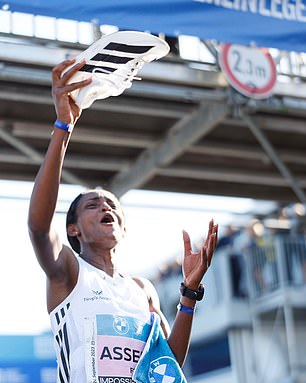
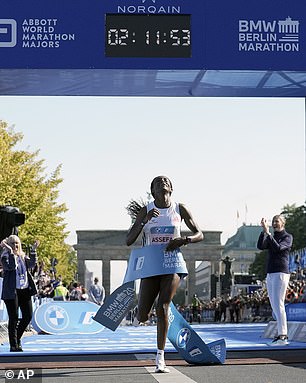
Runners around the world were stunned to see Tigist Assefa break the women’s marathon world record in Berlin this weekend
The new racing shoe from Adidas weighs only 138 grams.
For comparison, the average high-top Converse shoe weighs 340 grams – more than twice as heavy as the ADIZERO Adios Pro Evo 1.
It is also 40 percent lighter than any other Adidas racing super shoe.
This minimal weight not only improves running economy, but also offers runners greater energy return, according to the brand.
Patrick Nava, VP Product, Running & Credibility Sports at adidas, said: ‘We examined every element of a racing shoe and found a balance between what we could remove or change to reduce weight.
“Created with and for the fastest road racing athletes, this shoe is designed to help ambitious runners go even faster on race day.”
The ADIZERO Adios Pro Evo 1 features a unique rocker, placed at 60 percent of the length of the shoe.
“The first of its kind forefoot rocker provides forward momentum, resulting in record-breaking speed that improves the wearer’s running economy,” Adidas explains.
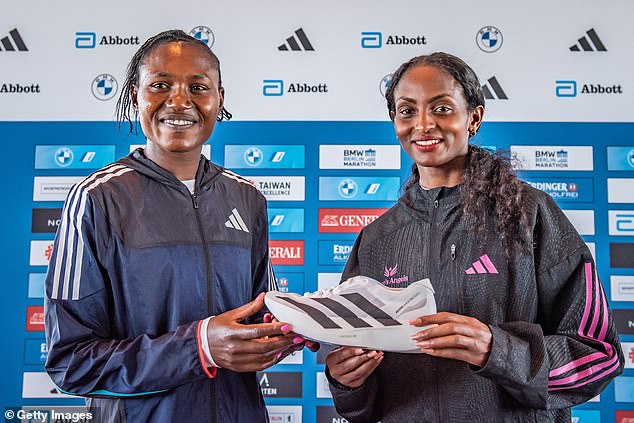
Sheila Chepkirui from Kenya and Tigist Assefa from Ethiopia wearing the Adidas running shoes Adizero Adios Pro Evo 1
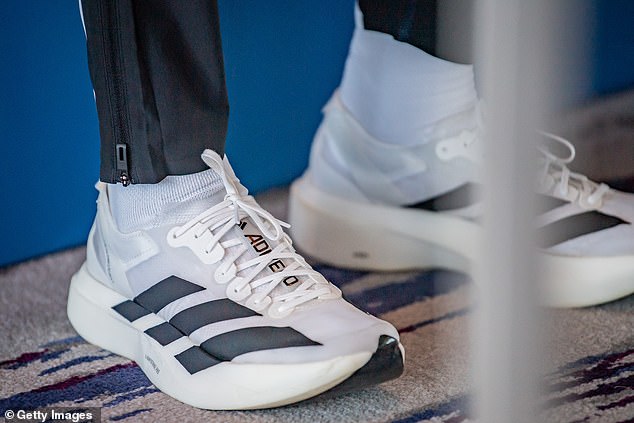
The new racing shoe from Adidas weighs only 138 grams. For comparison, the average high-top Converse shoe weighs 340 grams – more than twice as heavy as the ADIZERO Adios Pro Evo 1
To reduce weight, Adidas has ditched the conventional sockliner and used a new version of its Lightstrike Pro foam to form the midsole.
“The latest version of the record-breaking Lightstrike Pro foam is manufactured in a non-compression molding process,” it explains.
‘Made with an advanced manufacturing process, this not only significantly reduces weight but also provides greater energy return for runners.’
However, the biggest weight savings (70 grams) came from a new, advanced outsole.
Charlotte Heidmann, senior global product manager at Adidas, told Runner’s World: ‘It’s the thinnest and lightest outsole we’ve ever made.
‘It’s still (made of) rubber, but it’s completely flat, there are no grooves in it anymore.
‘But the grip is still the same – we tested it in the rain with our athletes and wear testers.’
Finally, the upper of the shoe is made of lightweight mesh, which is translucent, which is a metaphor for the lightness of the shoe.
“They allow me to put my full focus on the race, which is exactly what you want as an athlete,” said Assefa.
Unsurprisingly, the shoes aren’t cheap: they cost £400 in the UK and $500 in the US.
Despite this eye-watering price tag, runners won’t make much use of the trainers.
According to Ms. Heidmann, there is a disclaimer in the box stating that the shoe is designed for “one race – so one marathon – plus adjustment time.”
Assefa is not the only athlete using the new shoe.
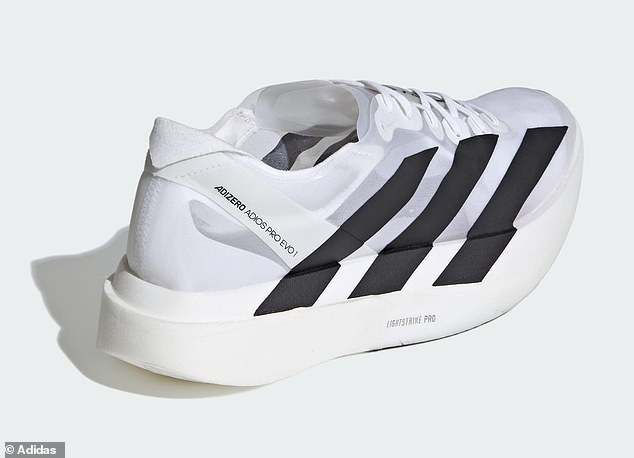
Unsurprisingly, the shoes aren’t cheap: they cost £400 in the UK and $500 in the US. Despite this eye-watering price tag, runners will not make much use of the sneakers, which are for single use
Other top runners who have tried the ADIZERO Adios Pro Evo 1 include reigning Olympic champion and two-time Major Marathon winner Peres Jepchirchir, two-time Major Marathon winner Benson Kipruto and German national champion Amanal Petros.
Despite the shoe having a thickness of 39mm (1mm below the 40mm limit set by World Athletics for road racing), the success of the new shoe is likely to reignite the debate among the running community over ‘technological doping’ .
This debate first reared its ugly head in 2016 with the launch of Nike’s £240 Vaporfly boots.
During the 2016 Olympic marathon in Rio, all three male medalists wore a prototype of the trainer, with the same technology being extended to track racing from 2018.
Experts predict that the shoe improved the running efficiency of highly skilled runners by four percent compared to a normal shoe, and improved performance by three percent.
“The same shoe gives you a huge variation between different athletes – in some cases even more than 10 percent,” says Professor Yannis Pitsiladis of the International Olympic Committee.
‘How you react to the shoe can determine whether you become an Olympian or watch it on TV.
‘You know who will win and who can qualify (for the Games).
‘Athletes qualified because they had access to a super shoe. And many who did not walk in these shoes did not qualify.”
